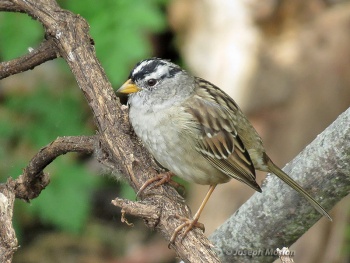
Photo © by Muskrat
Columbia County, northeastern Pennsylvania, USA, 16 October 2005
- Zonotrichia leucophrys
Identification

Photo © by Joseph Morlan
Pacifica, San Mateo County, California, USA, 31 March 2019
14–17 cm (5½-6¾ in)
Black and white stripes on their head, a grey face, brown streaked upper parts and a long tail. The wings are brown with white wing-bars and the underparts are grey. Their bill is pink or yellow. Details of the head pattern differ between subspecies; see Taxonomy section below. Immatures are similar to adult, but crown stripes are reddish-brown instead of black. Juveniles are heavily streaked below with brown head stripes.
Distribution
Breeds from Alaska and western Canada east to Labrador and northern Quebec. In western North America breeds south to central California and the mountains of northern Arizona and New Mexico. Winters in the southern and central United States (on the Atlantic coast as far north as Pennsylvania and Long Island) and in northern Mexico.
Taxonomy
Subspecies
There are five recognized subspecies[1]:
- Z. l. leucophrys:
- Central and eastern Canada to Newfoundland; winters to south-eastern US, Cuba, Jamaica
- Z. l. oriantha:
- Mountains of south-western Canada to south-western US; winters to southern Baja and central Mexico
- Z. l. gambelii:
- North Alaska and northern Yukon to south-central Canada; winters to northern Mexico
- Z. l. nuttalli:
- Coastal central California (Mendocino Co. to Santa Barbara Co.)
- Z. l. pugetensis:
- Coastal south-western British Columbia to north-western California; winters to south-western California
The latter three subspecies, sometimes grouped for identification purposes as "Gambel's White-crown," are distinguished by their white lores and orange (gambelii) to yellow (nutalli/pugetensis) bill. Z. l. gambelli has gray fringes to the back feathers while nuttalli and pugetensis have tan back fringes. (Nominate and oriantha share black lores and pink bill.)
Habitat
Winters in hedgerows and densely vegetated field edges, roadsides and streambanks, woodland and forest edges. In California it is an abundant nester in coastal scrub, but winters in a wide range of habitats, including dry deserts, as for instance in the Kelso Valley of Kern County.
Behaviour
Diet
They forage on the ground and in low vegetation, for beetles, bugs, seeds and plant material. They sometimes make short flights to catch flying insects.
Breeding
Monogamous, occasionally polygynous (nuttalli). Nest built by female, is a cup of dry grasses, sticks, dead leaves or moss lined with finer grasses and hair. Nest in a low bush or on ground. Clutch of 3–7 pale greenish to bluish eggs marked with brownish to reddish spots. Brood parasitism by Brown-headed Cowbird (Molothrus ater) most frequent races oriantha and nuttalli.
Vocalisation
Song variable, with many regional dialects, but distinctive. Usually starts with one to four clearly whistled notes, the second slightly lower, followed by three descending husky notes. Pacific coast birds usually start with a long, clear whistle that is higher-pitched than rest. Typical call a hard tsit, flatter in tone on Pacific coast.
Movements
Northern and montane populations are entirely migratory; south coastal nuttalli is sedentary, while more northern pugetensis is migratory. In central California banding data show that individuals, having chosen wintering area during first winter of life, return each year to same site.
Gallery
Click images to see larger version
Showing yellow wing linings of subspecies Z. l. nuttali/pugetensis
Photo & copy by Joseph Morlan
Half Moon Bay, California , USA, 3 October 2020
References
- Clements, J. F., T. S. Schulenberg, M. J. Iliff, S. M. Billerman, T. A. Fredericks, B. L. Sullivan, and C. L. Wood. 2019. The eBird/Clements Checklist of Birds of the World: v2019. Downloaded from http://www.birds.cornell.edu/clementschecklist/download/
- Rising, J. (2020). White-crowned Sparrow (Zonotrichia leucophrys). In: del Hoyo, J., Elliott, A., Sargatal, J., Christie, D.A. & de Juana, E. (eds.). Handbook of the Birds of the World Alive. Lynx Edicions, Barcelona. (retrieved from https://www.hbw.com/node/61912 on 6 April 2020).
- Chilton, G., M. C. Baker, C. D. Barrentine, and M. A. Cunningham (2020). White-crowned Sparrow (Zonotrichia leucophrys), version 1.0. In Birds of the World (A. F. Poole and F. B. Gill, Editors). Cornell Lab of Ornithology, Ithaca, NY, USA. https://doi.org/10.2173/bow.whcspa.01
- Byers, C., J. Curson, and U. Olsson. 1995. Sparrows and Buntings: A Guide to the Sparrows and Buntings of North America and the World. Houghton Mifflin, Boston.
- BirdForum Member observations
Recommended Citation
- BirdForum Opus contributors. (2025) White-crowned Sparrow. In: BirdForum, the forum for wild birds and birding. Retrieved 11 May 2025 from https://www.birdforum.net/opus/White-crowned_Sparrow
External Links
GSearch checked for 2020 platform.1







